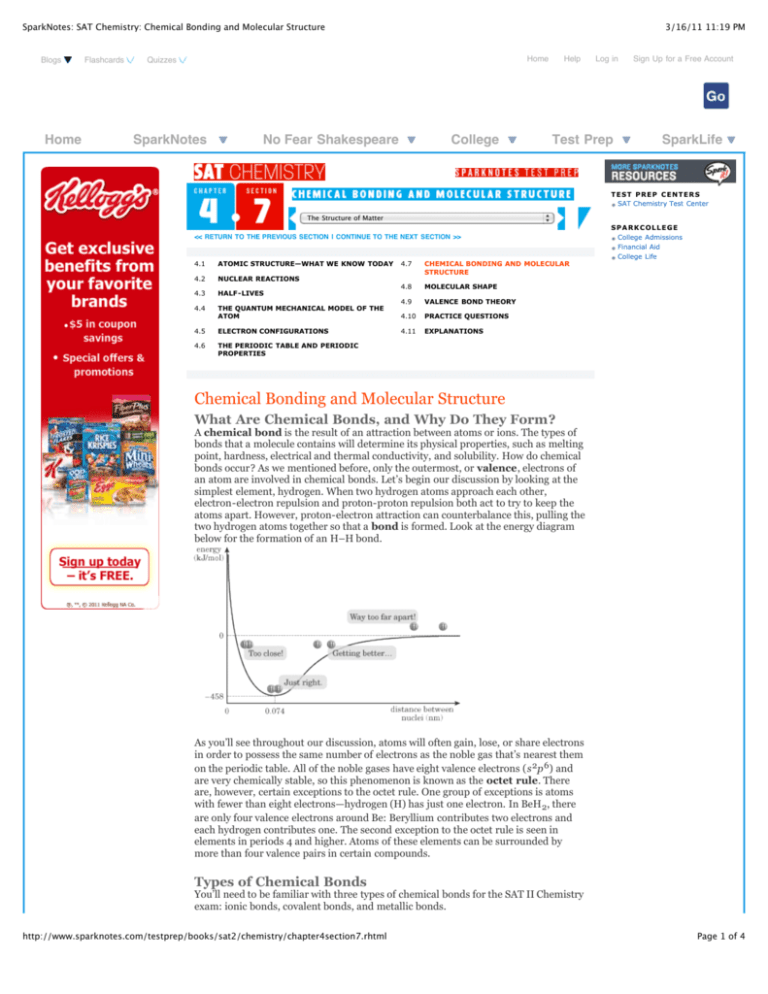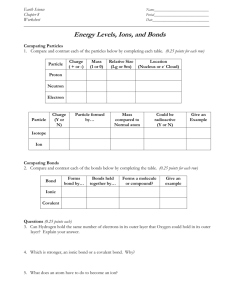
SparkNotes: SAT Chemistry: Chemical Bonding and Molecular Structure
Blogs
Home
Flashcards
3/16/11 11:19 PM
Home
Quizzes
SparkNotes
No Fear Shakespeare
College
Help
Log in
Test Prep
Sign Up for a Free Account
SparkLife
TEST PREP CENTERS
SAT Chemistry Test Center
The Structure of Matter
<< RETURN TO THE PREVIOUS SECTION | CONTINUE TO THE NEXT SECTION >>
4.1
ATOMIC STRUCTURE—WHAT WE KNOW TODAY
4.2
NUCLEAR REACTIONS
4.3
HALF-LIVES
4.4
THE QUANTUM MECHANICAL MODEL OF THE
ATOM
4.5
ELECTRON CONFIGURATIONS
4.6
THE PERIODIC TABLE AND PERIODIC
PROPERTIES
4.7
CHEMICAL BONDING AND MOLECULAR
STRUCTURE
4.8
MOLECULAR SHAPE
4.9
VALENCE BOND THEORY
4.10
PRACTICE QUESTIONS
4.11
EXPLANATIONS
SPARKCOLLEGE
College Admissions
Financial Aid
College Life
Chemical Bonding and Molecular Structure
What Are Chemical Bonds, and Why Do They Form?
A chemical bond is the result of an attraction between atoms or ions. The types of
bonds that a molecule contains will determine its physical properties, such as melting
point, hardness, electrical and thermal conductivity, and solubility. How do chemical
bonds occur? As we mentioned before, only the outermost, or valence, electrons of
an atom are involved in chemical bonds. Let’s begin our discussion by looking at the
simplest element, hydrogen. When two hydrogen atoms approach each other,
electron-electron repulsion and proton-proton repulsion both act to try to keep the
atoms apart. However, proton-electron attraction can counterbalance this, pulling the
two hydrogen atoms together so that a bond is formed. Look at the energy diagram
below for the formation of an H–H bond.
As you’ll see throughout our discussion, atoms will often gain, lose, or share electrons
in order to possess the same number of electrons as the noble gas that’s nearest them
on the periodic table. All of the noble gases have eight valence electrons (s 2p 6) and
are very chemically stable, so this phenomenon is known as the octet rule. There
are, however, certain exceptions to the octet rule. One group of exceptions is atoms
with fewer than eight electrons—hydrogen (H) has just one electron. In BeH 2, there
are only four valence electrons around Be: Beryllium contributes two electrons and
each hydrogen contributes one. The second exception to the octet rule is seen in
elements in periods 4 and higher. Atoms of these elements can be surrounded by
more than four valence pairs in certain compounds.
Types of Chemical Bonds
You’ll need to be familiar with three types of chemical bonds for the SAT II Chemistry
exam: ionic bonds, covalent bonds, and metallic bonds.
http://www.sparknotes.com/testprep/books/sat2/chemistry/chapter4section7.rhtml
Page 1 of 4
SparkNotes: SAT Chemistry: Chemical Bonding and Molecular Structure
3/16/11 11:19 PM
Ionic bonds are the result of an electrostatic attraction between ions that have
opposite charges; in other words, cations and anions. Ionic bonds usually form
between metals and nonmetals; elements that participate in ionic bonds are often
from opposite ends of the periodic table and have an electronegativity difference
greater than 1.67. Ionic bonds are very strong, so compounds that contain these types
of bonds have high melting points and exist in a solid state under standard
conditions. Finally, remember that in an ionic bond, an electron is actually
transferred from the less electronegative atom to the more electronegative element.
One example of a molecule that contains an ionic bond is table salt, NaCl.
Covalent bonds form when electrons are shared between atoms rather than
transferred from one atom to another. However, this sharing rarely occurs equally
because of course no two atoms have the same electronegativity value. (The obvious
exception is in a bond between two atoms of the same element.) We say that covalent
bonds are nonpolar if the electronegativity difference between the two atoms
involved falls between 0 and 0.4. We say they are polar if the electronegativity
difference falls between 0.4 and 1.67. In both nonpolar and polar covalent bonds, the
element with the higher electronegativity attracts the electron pair more strongly. The
two bonds in a molecule of carbon dioxide, CO 2, are covalent bonds.
Covalent bonds can be single, double, or triple. If only one pair of electrons is shared,
a single bond is formed. This single bond is a sigma bond (s), in which the
electron density is concentrated along the line that represents the bond joining the
two atoms.
However, double and triple bonds occur frequently (especially among carbon,
nitrogen, oxygen, phosphorus, and sulfur atoms) and come about when atoms can
achieve a complete octet by sharing more than one pair of electrons between them. If
two electron pairs are shared between the two atoms, a double bond forms, where
one of the bonds is a sigma bond, and the other is a pi bond (p). A pi bond is a
bond in which the electron density is concentrated above and below the line that
represents the bond joining the two atoms. If three electron pairs are shared between
the two nuclei, a triple bond forms. In a triple bond, the first bond to form is a
single, sigma bond and the next two to form are both pi.
Multiple bonds increase electron density between two nuclei: they decrease nuclear
repulsion while enhancing the nucleus-to-electron density attractions. The nuclei
move closer together, which means that double bonds are shorter than single bonds
and triple bonds are shortest of all.
Metallic bonds exist only in metals, such as aluminum, gold, copper, and iron. In
metals, each atom is bonded to several other metal atoms, and their electrons are free
to move throughout the metal structure. This special situation is responsible for the
unique properties of metals, such as their high conductivity.
Drawing Lewis Structures
Here are some rules to follow when drawing Lewis structures—you should follow
these simple steps for every Lewis structure you draw, and soon enough you’ll find
that you’ve memorized them. While you will not specifically be asked to draw Lewis
structures on the test, you will be asked to predict molecular shapes, and in order to
do this you need to be able to draw the Lewis structure—so memorize these rules! To
predict arrangement of atoms within the molecule
1. Find the total number of valence electrons by adding up group numbers of the
elements. For anions, add the appropriate number of electrons, and for
cations, subtract the appropriate number of electrons. Divide by 2 to get the
number of electron pairs.
2. Determine which is the central atom—in situations where the central atom has
a group of other atoms bonded to it, the central atom is usually written first.
For example, in CCl4, the carbon atom is the central atom. You should also
note that the central atom is usually less electronegative than the ones that
surround it, so you can use this fact to determine which is the central atom in
cases that seem more ambiguous.
3. Place one pair of electrons between each pair of bonded atoms and subtract the
number of electrons used for each bond (2) from your total.
4. Place lone pairs about each terminal atom (except H, which can only have two
electrons) to satisfy the octet rule. Leftover pairs should be assigned to the
central atom. If the central atom is from the third or higher period, it can
http://www.sparknotes.com/testprep/books/sat2/chemistry/chapter4section7.rhtml
Page 2 of 4
SparkNotes: SAT Chemistry: Chemical Bonding and Molecular Structure
3/16/11 11:19 PM
accommodate more than four electron pairs since it has d orbitals in which to
place them.
5. If the central atom is not yet surrounded by four electron pairs, convert one or
more terminal atom lone pairs to double bonds. Remember that not all
elements form double bonds: only C, N, O, P, and S!
Example
Which one of the following molecules contains a triple bond: PF3, NF 3, C2H 2, H 2CO,
or HOF?
Explanation
The answer is C2H 2, which is also known as ethyne. When drawing this structure,
remember the rules. Find the total number of valence electrons in the molecule by
adding the group numbers of its constituent atoms. So for C2H 2, this would mean C =
4
2 (since there are two carbons) = 8. Add to this the group number of H, which
is 1, times 2 because there are two hydrogens = a total of 10 valence electrons. Next,
the carbons are clearly acting as the central atoms since hydrogen can only have two
electrons and thus can’t form more than one bond. So your molecule looks like this:
H—C—C—H. So far you’ve used up six electrons in three bonds. Hydrogen can’t
support any more electrons, though: both H’s have their maximum number! So your
first thought might be to add the remaining electrons to the central carbons—but
there is no way of spreading out the remaining four electrons to satisfy the octets of
both carbon atoms except to draw a triple bond between the two carbons.
For practice, try drawing the structures of the other four compounds listed.
Example
How many sigma (s) bonds and how many pi (p) bonds does the molecule ethene,
C2H 4, contain?
Explanation
First draw the Lewis structure for this compound, and you’ll see that it contains one
double bond (between the two carbons) and four single bonds. Each single bond is a
sigma bond, and the double bond is made up of one sigma bond and one pi bond, so
there are five sigma bonds and one pi bond.
Exceptions to Regular Lewis Structures—Resonance
Structures
Sometimes you’ll come across a structure that can’t be determined by following the
Lewis dot structure rules. For example, ozone (O3) contains two bonds of equal bond
length, which seems to indicate that there are an equal number of bonding pairs on
each side of the central O atom. But try drawing the Lewis structure for ozone, and
this is what you get:
We have drawn the molecule with one double bond and one single bond, but since we
know that the bond lengths in the molecule are equal, ozone can’t have one double
and one single bond—the double bond would be much shorter than the single one.
Think about it again, though—we could also draw the structure as below, with the
double bond on the other side:
Together, our two drawings of ozone are resonance structures for the molecule.
Resonance structures are two or more Lewis structures that describe a molecule:
their composite represents a true structure for the molecule. We use the doubledirectional arrows to indicate resonance and also bracket the structures or simply
draw a single, composite picture.
http://www.sparknotes.com/testprep/books/sat2/chemistry/chapter4section7.rhtml
Page 3 of 4
SparkNotes: SAT Chemistry: Chemical Bonding and Molecular Structure
3/16/11 11:19 PM
Let’s look at another example of resonance, in the carbonate ion CO 32- :
Notice that resonance structures differ only in electron pair positions, not atom
positions!
Example
Draw the Lewis structures for the following molecules: HF, N2, NH 3, CH 4, CF 4, and
NO +.
Explanation
<< RETURN TO THE PREVIOUS SECTION | CONTINUE TO THE NEXT SECTION >>
Help | Feedback | Make a request | Report an error | Send to a friend
The Structure of Matter
When your books and teachers donʼt make sense, we do.
Contact Us | Privacy Policy | Terms and Conditions | About | Sitemap | Advertise
Fiction Books | Textbooks | eTextbooks | Classic Books | Used Books | Teen Books | nook | eReader
©2010 SparkNotes LLC, All Rights Reserved
http://www.sparknotes.com/testprep/books/sat2/chemistry/chapter4section7.rhtml
Page 4 of 4








